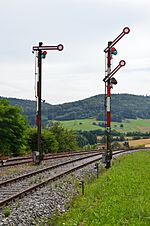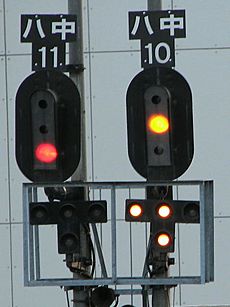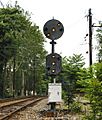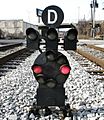Railway signal facts for kids
A railway signal is a special light or sign that tells train drivers what to do. It gives them important instructions or warnings. Drivers look at the signal and then know how to drive the train safely. For example, a signal might tell a driver how fast they can go. It could also tell them to stop the train.
How Railway Signals Help Trains
When trains first started, signals just showed "stop" or "go." But as more trains used the tracks, this wasn't enough. So, new signals were added. One important addition was the "distant signal." This signal was placed before a "stop signal." It warned drivers that they were coming up to a signal that might tell them to stop.
This helped trains go faster overall. Drivers didn't have to slow down just to see if the next signal was a stop sign. They got a warning ahead of time.
Signals are used to tell drivers many things. They can show:
- If the track ahead is clear or blocked.
- If the driver is allowed to go forward.
- If the points (tracks that move to change a train's path) are set correctly.
- Which way the points are set.
- How fast the train can travel.
- What the next signal will show.
- If the crew needs to pick up special instructions for the train.
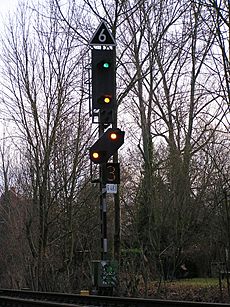
Where You Can Find Signals
Signals are placed in many important spots along the railway tracks. You might see them:
- At the start of a new section of track.
- Before a moving part of the track, like points or a swingbridge (a bridge that swings open for boats).
- Before other signals, to give an early warning.
- Before a level crossing (where tracks cross a road).
- At a switch or turnout, where tracks split.
- Before platforms or other places where trains often stop.
- At stations where trains pick up special orders.
Main railway lines usually have signals all the time. On a double track railway, signals usually face one direction on each track. This means trains only go one way on each track. But sometimes, signals face both directions on both tracks. This is called "bidirectional signalling." It means trains can go either way on those tracks. Signals are usually not used for controlling trains in sidings or yard areas. These are places where trains are stored or moved around slowly.
Images for kids
-
Mechanical semaphore signals at Kościerzyna in Poland
-
Network Rail (UK) two-aspect colour light railway signal set at 'danger'
-
Railway signal in Ploiești West railway station, Romania. This type of signal is based on the German Ks signals.
-
Dwarf signal at Utrecht Centraal, Netherlands
See also
 In Spanish: Señalización ferroviaria para niños
In Spanish: Señalización ferroviaria para niños


